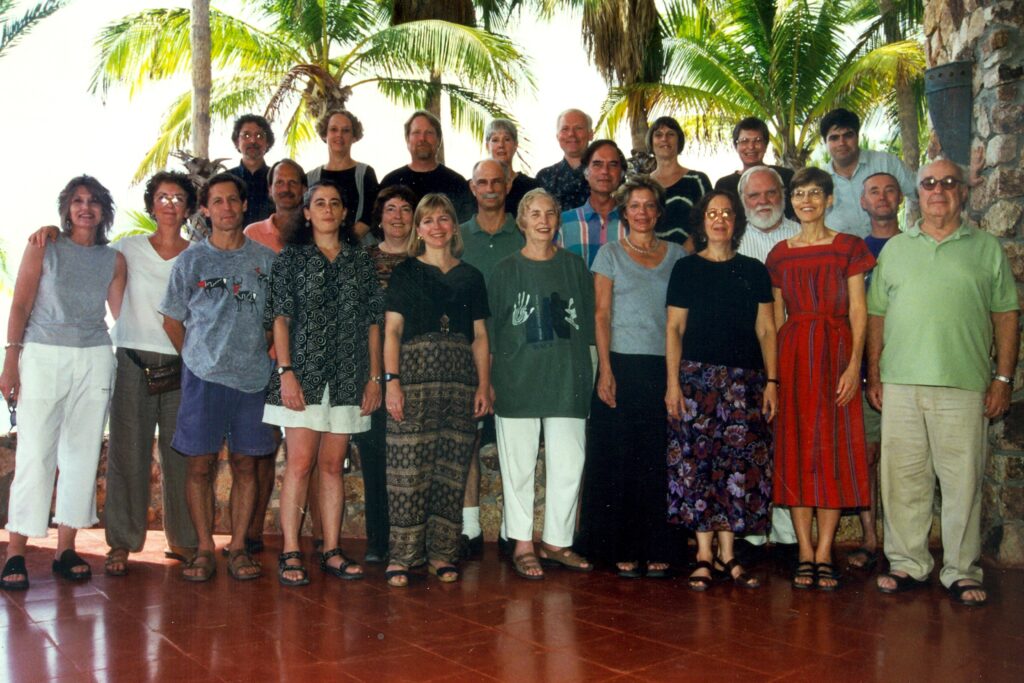Anthropology at the End of the Century
Date
Oct 28 - Nov 5, 1999Organized by
Sydel SilvermanLocation
Hotel Cabo San Lucas, Baja California Sur, MexicoPublications
"The Beast on the Table: Conferencing with Anthropologists," by Sydel Silverman. Altamira Press: Walnut Creek, CA. 2002.Participants
- Timothy G. Bromage City University of New York, Hunter College, USA
- Linda M. Fedigan University of Alberta, Canada
- William A. Foley University of Sydney, Australia
- Kathleen R. Gibson University of Texas-Dental Branch, USA
- Alan Goodman Hampshire College, USA
- John Gumperz University of California, Berkeley, USA
- Gilbert H. Herdt San Francisco State University, USA
- Thomas L. Leatherman University of South Carolina, USA
- Shirley Lindenbaum City University of New York, Graduate Center, USA
- Margaret Lock McGill University, Canada
- William C. McGrew Miami University of Ohio, USA
- Susan McKinnon University of Virginia, USA
- Barbara D. Miller George Washington University, USA
- James A. Moore City University of New York, Queens College, USA
- John H. Moore University of Florida, USA
- Mary Ellen Morbeck University of Arizona, USA
- Nancy J. Parezo University of Arizona, USA
- Anna C. Roosevelt University of Illinois, USA
- Nina Glick Schiller University of New Hampshire, USA
- Sydel Silverman Wenner-Gren Foundation, USA
- Carla M. Sinopoli University of Michigan, USA
- Donald F. Tuzin University of California-San Diego, La Jolla, USA
ORGANIZER’S STATEMENT: The purpose of this conference was to make a particular kind of assessment of the state of anthropology at the turn of the century. Centennial transitions invite reflections of all kinds on where we have been, where we are now, and where we are going. This is true for anthropology as a discipline, as it is for every other institution and social entity. Because the Wenner-Gren Foundation has a unique window on the discipline in its historical development and present condition, it seemed appropriate to mark this transition by drawing on the perspectives we have gained through our programs.
Most particularly, the conferences held under the International Symposium Program have served to bring together diverse developments in a field, problem, or topic, to assess the state of our understanding, and to chart future courses. The symposia have ranged over all the subfields of anthropology, often highlighting connections among the subfields as well as with related disciplines. They have sought to identify “cutting-edge” issues, to air current controversies, and to advance promising new directions in anthropology. They have also strived to range across anthropology internationally, by including participants and research developments from diverse countries. It was felt that the symposia of the past decade could therefore serve as strategic points of departure to aid in our collective reflections on the state of anthropology at this time – its problems, progress, and prospects.
This conference brought together the organizers of each of the symposia held since 1987; where there were two or more organizers, one represented the collaborative pair or group. Each participant prepared a paper covering the following questions with respect to his/her symposium:
- What were the central goals, problems, or issues of the symposium in relation to the state of the field at the time? How did it build on, challenge, or rephrase research that came before it? Why was this symposium needed at this time?
- How was the symposium developed to achieve its goals, and what happened during the symposium itself.
- What were the “after-effects” of the symposium? How were the goals carried forward, such as through publication of the results?
- What has happened in the field, problem, or topic of the symposium subsequently, whether or not as a direct or indirect result of the symposium?
The discussions at the conference were extremely spirited and provided many insights into the recent history of anthropology and its prospects for the future. Especially useful were the many exchanges that cut across subfields and specialties.
It was the consensus of the group that there is much hope for the survival of an integrative anthropology, but also the urgent need for anthropology as a discipline to address reductive accounts of social life, both critically and publicly. As a first step, Susan McKinnon, Alan Goodman, and William Foley together conceived the idea of a panel—“Anthropology United: Challenging Bio-social Reductivisms in the Academy, Popular Media, and Public Policy”—which convened at the November 2000 meeting of the American Anthropology Association, whose theme was, coincidentally, “The Public Face of Anthropology.”
The publication of Complexities: Beyond Nature and Nurture followed upon the broad interest generated by the AAA panel.
Wenner-Gren Symposium #125
